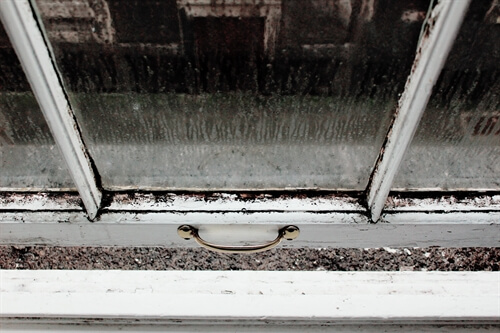Domestic black mould thrives in our cool damp climate, and loves to grow anywhere in the home where moisture accumulates. Black mould is linked to medical problems, including nose, eye and skin irritation. It can also affect the immune system and may worsen asthma. Babies and small children are particularly affected by black mould, as is anyone with a skin condition or weakened immune system.
Mould can also ruin your possessions, so it’s really important to keep on top of it.
But what actually is black mould?
Black mould is caused by various species of fungi. Two common causes of black mould in houses are Cladosporium and Alternaria . A third, Stachybotrys chartarum, causes sick building syndrome by emitting toxins and has been linked to a potentially fatal lung disease in babies.
How do I know if I’ve got black mould in my home?
Black mould looks like black speckles on walls but it can also affect wood, carpets and other fabrics. It occurs particularly near windows and in bathrooms and kitchens.
How can I get rid of black mould?
If it’s only a small amount of black mould, you can clean it off with hot water and bleach. Mould and mildew treatments are available, too. But you do need to investigate the cause of the black mould in your home and correct it, or the mildew spots will just come back.
Painting over mould won’t solve your problem
You can’t resolve a mould problem by painting over it. It will come back unless you fix whatever is causing the mildew to grow (for example, a leak, condensation or poor ventilation).
Get professional help with black mould in your home
If you have any doubts about your ability to handle a mould problem, it’s best to call in professional help. Landlords and housing associations have a responsibility to deal with black mould and tenants should let them know as soon as they spot it. Shelter has a template letter to help with reporting black mould.
How can I prevent black mould?
Minimising damp in your home will help to prevent black mould. And keeping your home heated to 15C will help to stop the formation of condensation on which mould thrives.
Ventilate when cooking and showering, too, using extractor fans that go to the outside. Your clothes drying habits will have an impact on humidity levels in your home. Drying clothing outside is best; but if that’s not possible, use a condensing tumble dryer or one that vents to the outside.
It’s a good habit to open your bedroom window first thing in the morning for 10 or 15 minutes, as this will improve air circulation.
Condensation may form on outside walls behind large piece of furniture, or items stacked against the wall. It may help to improve the insulation of these walls. Moving the furniture away from the wall will create an air gap that will reduce condensation, too. Decluttering might allow you to get rid of (for example) a large wardrobe or shelving unit. Or you could temporarily put some domestic goods into storage until the mould problem is resolved.
A word of warning: make sure anything you store is clean, dry and free from mould before packing it away, as your self-storage insurance won’t provide coverage for damage to items that were stored in your unit already damp or mouldy.
Decluttering will also make it easier to maintain your home and you will be more likely to spot any black mould issues before they spread. Regular checks for condensation and damp will go a long way to keeping black mould under control.
It’s really important to keep black mould at bay for the sake of your wellbeing: you and your family deserve a safe, healthy, mould-free home.


